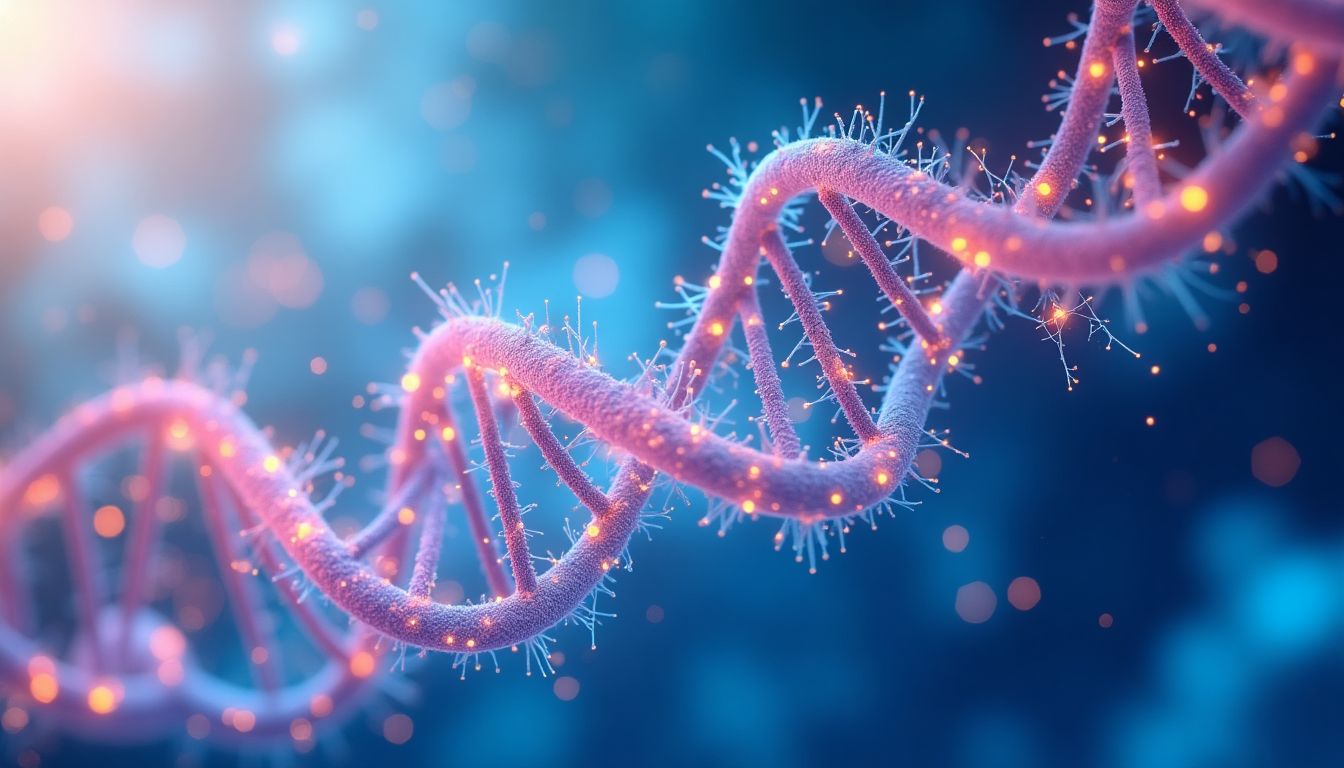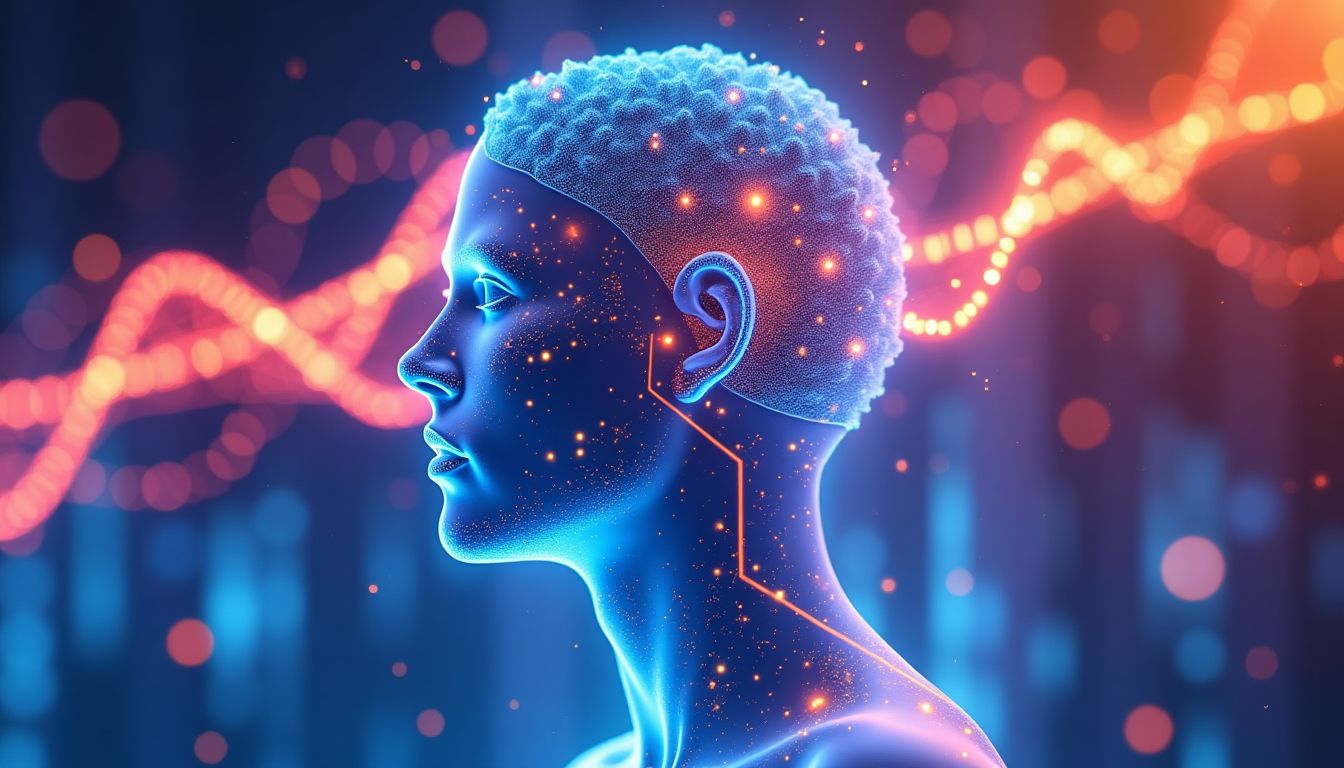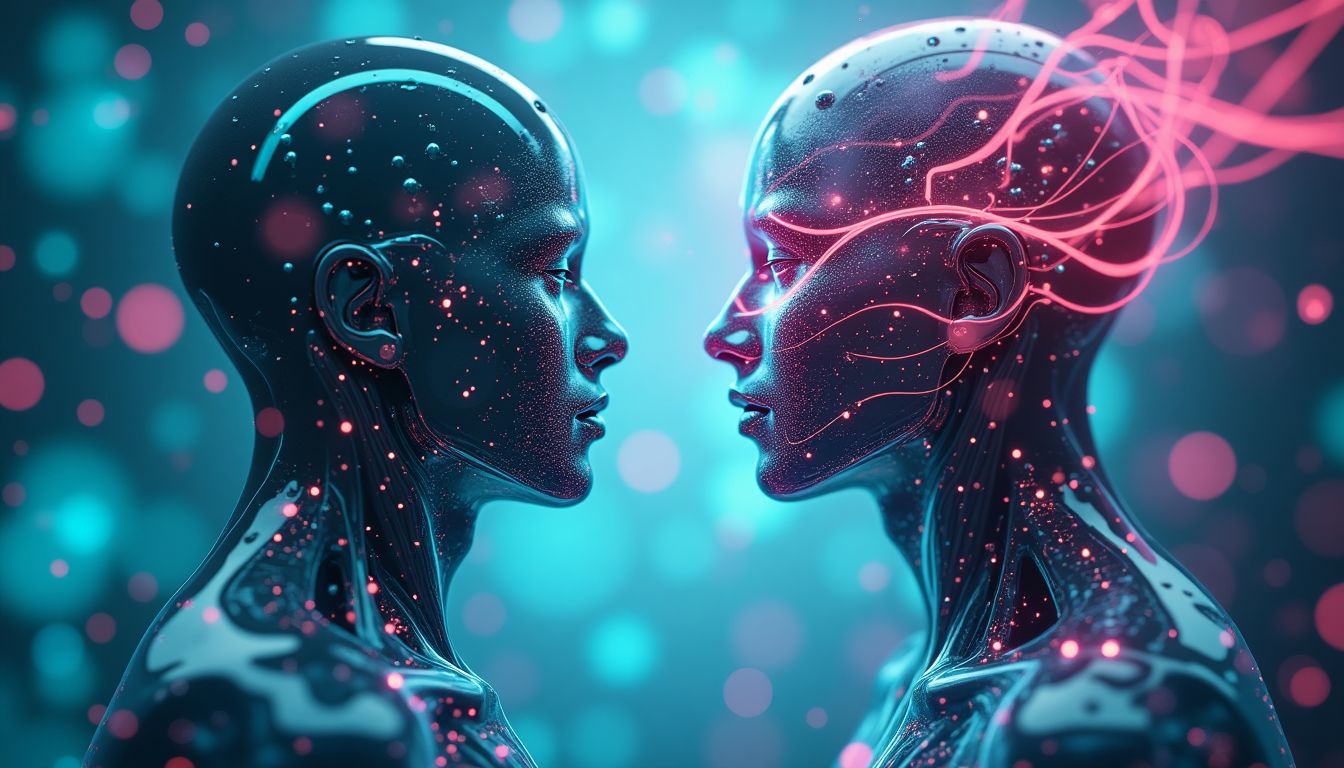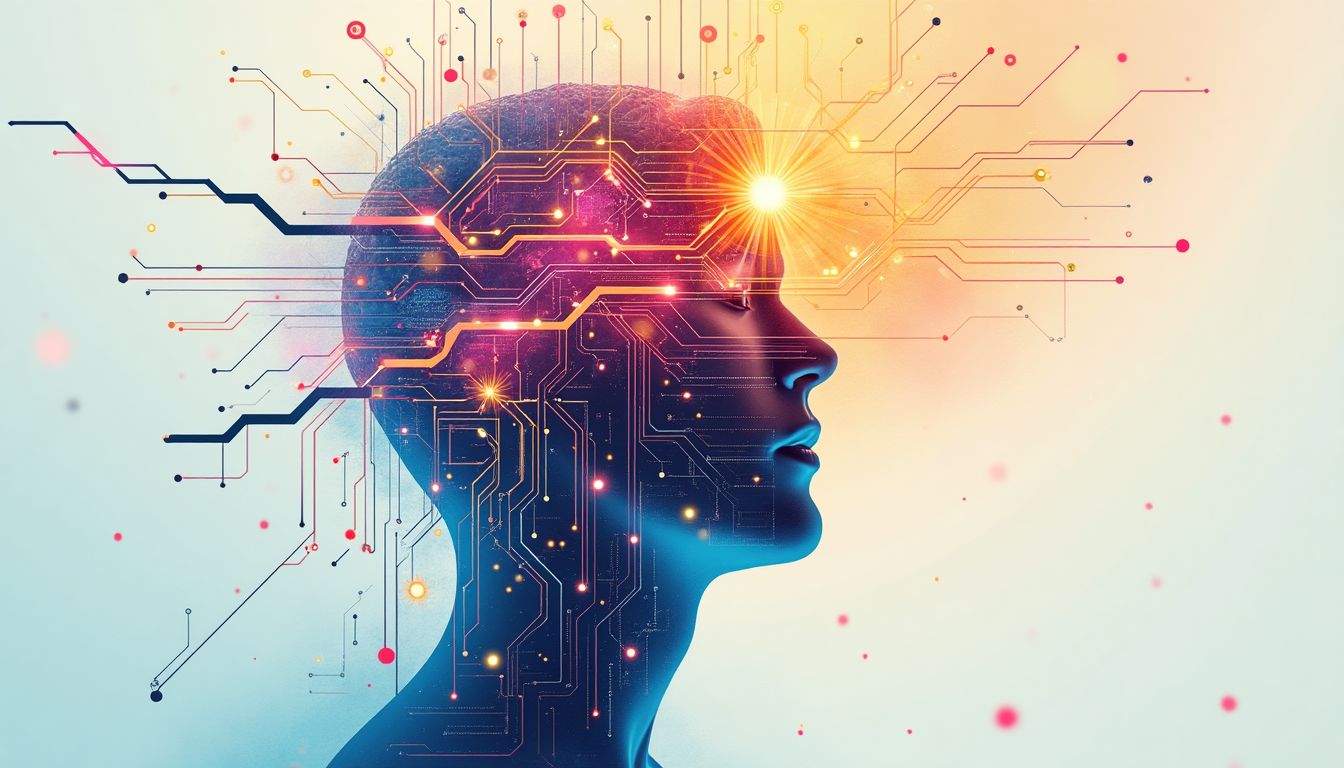Do not separate the Introduction and Point 1 with horizontal lines.
What if the next stage of human evolution isn’t driven by nature, but by machines? Could artificial intelligence (AI) be the catalyst that transforms humanity into a species of superhumans? For centuries, human evolution has been a slow, unpredictable dance choreographed by natural selection. But now, AI is stepping onto the stage, poised to rewrite the script. From CRISPR gene editing to brain-computer interfaces (BCIs) like those being developed by Neuralink, we’re on the cusp of a revolution that could redefine what it means to be human.
Scientists like Jennifer Doudna, the co-inventor of CRISPR, and futurists like Ray Kurzweil have long speculated about the role of technology in shaping our future. Even Oxford University philosopher Nick Bostrom has warned about the ethical minefields of "superintelligence." But what if AI isn’t just a tool or a threat? What if it’s the next step in our evolutionary journey?
This isn’t science fiction anymore. It’s science fact. AI is already optimizing CRISPR, enhancing brain-computer interfaces, and simulating evolutionary pathways. But with great power comes great responsibility—and a laundry list of ethical dilemmas. Will we use these technologies to create a utopia of superhumans, or will we widen the gap between the haves and the have-nots? Buckle up, because we’re about to explore the brave new world of AI-enhanced evolution.
1. The Science of AI-Driven Genetic Enhancements
1.1 CRISPR and AI Collaboration
Think of CRISPR as the scissors of the genetic world—a precise tool for cutting and editing DNA. But even the sharpest scissors need a steady hand, and that’s where AI comes in. AI is like the master tailor, optimizing CRISPR cuts to minimize errors and maximize results. For example, research shows that AI can predict CRISPR’s off-target effects with stunning accuracy, making gene editing safer and more efficient.
But AI’s role doesn’t stop at safety. It’s also identifying potential genetic modifications that could enhance disease resistance, extend longevity, or even boost cognitive abilities. Imagine a world where AI helps us reprogram our genes to resist diseases like Alzheimer’s or cancer. It’s not just possible; it’s already happening. Companies like 10x Genomics are using AI to analyze massive datasets, uncovering patterns that could lead to groundbreaking therapies.
1.2 Personalized Genetic Medicine
One size doesn’t fit all, especially when it comes to genetics. That’s why AI is revolutionizing personalized medicine. By analyzing an individual’s genome, AI can tailor treatments to their unique genetic makeup. For instance, studies have shown how AI can predict which cancer treatments will work best for specific patients, reducing trial and error in chemotherapy.
But it’s not just about treating diseases. AI is also paving the way for genetic enhancements—think of it as a software update for your DNA. Want to live longer, think faster, or run marathons in your 80s? AI might hold the key. Companies like 23andMe are already collecting vast amounts of genetic data, and AI is sifting through it to unlock the secrets of human potential.
1.3 Ethical and Safety Concerns
Of course, with great power comes great responsibility. AI-driven genetic enhancements raise a host of ethical and safety concerns. What if the CRISPR scissors cut in the wrong place? What if AI’s predictions are wrong, leading to unintended consequences? And let’s not forget the elephant in the room: "designer babies." The idea of editing embryos to create superhumans might sound like something out of a dystopian novel, but it’s a real possibility—and a real ethical minefield.
There’s also the risk of genetic inequality. Will only the wealthy have access to these enhancements, creating a new class of superhumans? Philosophers like Nick Bostrom have warned about the societal impacts of such disparities. The question isn’t just whether we can enhance humanity—it’s whether we should.
2. Brain-Computer Interfaces: Merging Humans with Machines
2.1 Neuralink and Beyond
Imagine a world where you can control your computer, phone, or even your coffee maker with just your thoughts. Sounds like science fiction, right? Thanks to companies like Neuralink, founded by Elon Musk, this futuristic dream is inching closer to reality. Brain-Computer Interfaces (BCIs) are devices that connect your brain directly to machines, allowing for seamless communication between human thought and technology.
But Neuralink isn’t the only player in the game. Researchers at MIT and Stanford University are also making strides in this field. While current BCIs have limitations—like requiring invasive surgery or having limited functionality—AI could change the game entirely. By enhancing the precision and capabilities of these devices, AI could make BCIs more accessible and powerful, turning us into real-life cyborgs. Just don’t expect to download kung fu skills like Neo from The Matrix—yet.
2.2 Cognitive Augmentation
What if you could boost your memory, learn new skills in minutes, or solve complex problems with ease? That’s the promise of AI-powered BCIs. By analyzing neural activity, AI could identify patterns and enhance cognitive functions in real-time. Think of it as a personal brain trainer that’s always on, helping you become smarter, faster, and more efficient.
But with great power comes great responsibility—and a lot of ethical questions. If AI can read your thoughts, who owns that data? What happens if it falls into the wrong hands? Privacy concerns are a major hurdle in the development of BCIs. After all, no one wants their deepest thoughts hacked or sold to the highest bidder. As the saying goes, “With great power comes the need for great privacy settings.”
2.3 Applications in Medicine and Beyond
BCIs aren’t just for tech enthusiasts—they have the potential to revolutionize medicine. For individuals with disabilities, BCIs could restore mobility, communication, and independence. Imagine a person with paralysis being able to control a robotic arm or type a message just by thinking. It’s not just life-changing—it’s life-giving.
But the applications don’t stop there. BCIs could transform education by making learning faster and more immersive. They could change the way we work by enabling direct brain-to-computer communication. And they could even redefine entertainment, allowing us to experience virtual worlds with unparalleled realism. The possibilities are endless—and so are the questions. Will we become too dependent on technology? Will we lose touch with our humanity? Or will we simply evolve into something entirely new?
3. The Ethical Landscape of AI-Enhanced Evolution
3.1 Equity and Access
Here’s the elephant in the room: what happens if only the rich can afford AI-enhanced brains and bodies? The risk of creating a “superhuman elite” is real, and it’s a major ethical concern. If genetic enhancements and BCIs are only available to the wealthy, we could end up with a society divided not just by wealth, but by biology.
To avoid this dystopian future, we need strategies to ensure equitable access to these technologies. Governments, companies, and nonprofits will need to work together to make AI-driven enhancements affordable and accessible to everyone. Because let’s face it—no one wants to live in a world where the 1% are literally superhuman.
3.2 Autonomy and Consent
Who gets to decide what enhancements are made to your body or brain? This question is at the heart of the ethical debate around AI-driven evolution. If AI is making decisions about your genetic code or neural activity, how do we ensure that you’re giving informed consent? And what happens if you change your mind?
These are complex questions that don’t have easy answers. But one thing is clear: transparency and choice are essential. People need to have control over their own bodies and minds, whether they’re opting for enhancements or choosing to stay “natural.” After all, autonomy is what makes us human—or at least it should.
3.3 Long-Term Implications
What happens when AI-enhanced humans start having babies? Will their children inherit their enhancements? Will humanity split into two separate species—one enhanced, one not? These are the kinds of questions that keep ethicists up at night.
The long-term societal impacts of AI-driven evolution are impossible to predict, but they’re worth considering. Will we lose something essential about being human? Or will we gain new abilities and perspectives that enrich our species? One thing’s for sure: the future is going to be weird—and fascinating.
4. The Role of AI in Evolutionary Research
4.1 Simulating Evolution
Picture this: artificial intelligence working like a crystal ball for human evolution. AI can model and predict the outcomes of genetic and neural enhancements, giving scientists a glimpse into the future. By analyzing vast amounts of data, AI can simulate how specific genetic changes might play out over generations. This isn’t science fiction—it’s happening right now in labs like those at DeepMind and MIT. For example, researchers are using AI to study how CRISPR edits could affect long-term health or how brain-computer interfaces might evolve over time. The possibilities are endless, but so are the challenges. AI models are only as good as the data they’re trained on, and human biology is incredibly complex.
4.2 Accelerating Scientific Discovery
AI is like a turbocharger for science. It can sift through mountains of data in seconds, identifying patterns and connections that would take humans years to uncover. In evolutionary research, AI is helping scientists pinpoint potential targets for genetic enhancements and test hypotheses faster than ever. Take the collaboration between Harvard and Stanford—they’re using AI to explore how certain genes influence aging. This isn’t just about extending life; it’s about improving the quality of life as we age. AI is also breaking down barriers between disciplines, bringing together geneticists, neuroscientists, and AI researchers to tackle big questions about human evolution.
- Identifying Enhancement Targets: AI analyzes genetic data to find areas ripe for improvement.
- Testing Hypotheses: AI runs simulations to predict the outcomes of genetic changes.
- Interdisciplinary Collaboration: AI connects researchers from different fields to solve complex problems.
4.3 Limitations and Challenges
While AI is a powerful tool, it’s not a magic wand. Human biology is full of mysteries that even the most advanced AI can’t unravel yet. For instance, the way genes interact with each other and the environment is incredibly complex. AI models can make predictions, but they’re not always accurate. There’s also the challenge of data quality—garbage in, garbage out. To make AI-driven evolution a reality, we need better data, smarter algorithms, and collaboration between AI experts and biologists. It’s a monumental task, but the rewards could be life-changing.
| Challenge | Solution |
|---|---|
| Complexity of human biology | Develop more advanced AI models that can handle complex data. |
| Data quality | Improve data collection methods and ensure datasets are diverse and representative. |
| Interdisciplinary collaboration | Create platforms that bring together AI researchers and biologists. |
5. The Future of Humanity: Superhuman or Posthuman?
5.1 Defining Superhumanity
What does it mean to be “superhuman”? Imagine having the strength of an Olympic athlete, the memory of a supercomputer, and the emotional intelligence of a therapist—all combined in one person. With AI-driven enhancements, this could become a reality. Superhumanity isn’t just about physical or cognitive abilities; it’s about transcending our current limitations. For example, AI-powered brain-computer interfaces could give us the ability to learn new skills in minutes or communicate telepathically. It’s a future where the line between human and machine becomes increasingly blurry.
5.2 Posthumanism and Beyond
Posthumanism takes the idea of superhumanity a step further. It’s about moving beyond our biological constraints entirely. Think of it as upgrading humanity to version 2.0. With technologies like Neuralink and gene editing, we could enhance not just our bodies and minds, but our very essence as a species. Philosophers like Nick Bostrom are already debating what this means for our identity and values. Will we still be “human” if we’re part machine? These questions are as thrilling as they are unsettling.
5.3 A New Evolutionary Paradigm
AI isn’t just changing how we evolve—it’s redefining evolution itself. Traditionally, evolution has been a slow, random process driven by natural selection. But with AI, we can take control of our own evolution, guiding it in specific directions. This isn’t just about improving individual traits; it’s about shaping the future of humanity as a whole. Imagine a world where humans and machines evolve together, creating a new kind of intelligence that’s greater than the sum of its parts. It’s a bold vision, but one that’s within our reach—if we’re willing to embrace it.
- Guided Evolution: AI helps us steer our own evolution, making it faster and more precise.
- Collaborative Intelligence: Humans and machines work together to create new forms of intelligence.
- A New Era: We’re on the brink of a new chapter in human history, where the possibilities are limited only by our imagination.
Use a numbered HTML ordered list for the Action Schedule/roadmap in Point 6. Ensure the conclusion is a little over 300 words by expanding on your thoughts while being hopeful yet cautiously optimistic. Incorporate a few powerful quotes by thought leaders or through the annals of history and/or literature to anchor your ideas.
For the Action Schedule/Roadmap add a roster of key participants and make it very detailed showing exactly what each person, group, organization or country should do. Use bullets to separate names from responsibilities. By names I mean ones relevant to this topic. Also include the people already highlighted in the body of the article. Group them accordingly and put them together with their organizations, countries or affiliations. Ensure the organizations and scholarly learning institutions, companies, laboratories, corporations, and govt agencies mentioned are all linked and include URL links to their official websites or their Wikipedia, IMDB pages or official social media accounts.
6. AI Solutions: How Would AI Tackle This Issue?
6.1 Optimizing Genetic Enhancement Algorithms
To harness AI in genetic enhancements, the focus must be on developing robust algorithms capable of predicting outcomes with high accuracy. AI can be trained on vast genomic datasets to identify patterns and predict the effects of specific gene edits. For instance, machine learning models like deep neural networks can analyze CRISPR-Cas9 guide RNA efficiency. Companies like DeepMind are already pioneering this space with tools like AlphaFold, which predicts protein structures. By integrating such models with genome editing technologies, AI can minimize off-target effects and maximize the precision of edits.
6.2 Enhancing BCI Capabilities
Brain-computer interfaces (BCIs) stand to benefit immensely from AI. Neural signal decoding, a complex task, can be streamlined using AI to interpret brain activity in real time. Projects like Neuralink, founded by Elon Musk, aim to develop AI-enhanced BCIs that allow seamless communication between the human brain and machines. AI can also improve the feedback loop in BCIs, enabling quicker and more accurate responses. For example, machine learning algorithms can be used to refine neural data interpretation, making BCIs more effective for medical and non-medical applications alike.
6.3 Ethical AI Frameworks
As AI drives advancements in human evolution, ethical frameworks must be established to ensure fairness, consent, and transparency. Organizations like the Future of Life Institute and Object Management Group (OMG) are already working on guidelines for AI governance. These frameworks should address issues like data privacy, algorithmic bias, and informed consent. AI systems must be designed to prioritize human autonomy, ensuring that individuals retain control over their genetic and neural data.
6.4 Collaborative Research Platforms
AI-powered platforms can facilitate interdisciplinary research, bringing together geneticists, neuroscientists, and ethicists. Platforms like ResearchGate and Dataverse can host shared datasets, enabling global collaboration. By leveraging AI to analyze and interpret these datasets, researchers can accelerate discovery and innovation. Such platforms should also include tools for ethical review and public engagement, ensuring that advancements are made responsibly.
Action Schedule/Roadmap (Day 1 to Year 2)
- Day 1: Assemble a global task force of geneticists, neuroscientists, AI researchers, and ethicists.
- Jennifer Doudna: CRISPR pioneer leading the genetic enhancement team.
- Elon Musk: Overseeing BCI development through Neuralink.
- Demis Hassabis: CEO of DeepMind, focusing on AI optimization.
- Fei-Fei Li: AI ethics expert from Stanford University.
- Day 2: Launch an international database for genomic and neural data.
- National Institutes of Health (NIH): Hosting the database in collaboration with global health organizations.
- European Bioinformatics Institute (EBI): Providing expertise in data management.
- Week 1: Begin training AI models on existing genetic and neural datasets.
- Google AI: Leveraging their cloud infrastructure for model training.
- OpenAI: Developing advanced algorithms for data analysis.
- Week 2: Organize workshops to establish ethical guidelines for AI-driven evolution.
- Future of Life Institute: Leading the ethical framework development.
- World Health Organization (WHO): Ensuring global health standards are met.
- Month 1: Start pilot studies on AI-optimized CRISPR treatments.
- Broad Institute: Conducting clinical trials in collaboration with Harvard and MIT.
- 23andMe: Providing genomic data for personalized treatments.
- Month 2: Develop prototypes for AI-enhanced BCIs.
- Neuralink: Leading BCI prototype development.
- DARPA: Funding advanced neural interface research.
- Year 1: Release the first AI-driven genetic therapies for clinical trials.
- NIH and FDA: Overseeing regulatory approval and safety testing.
- Year 1.5: Launch AI-powered BCI devices for medical applications.
- Medical Device Companies: Scaling production and distribution.
- Year 2: Evaluate the societal impacts of AI-driven enhancements and refine ethical frameworks.
- United Nations: Facilitating global discussions on ethical implications.
The Dawn of AI-Enhanced Evolution: A New Chapter for Humanity
The potential for AI to guide human evolution is both exhilarating and daunting. As we stand on the precipice of a new era, the promise of superhuman abilities tantalizes the imagination. Could we, through the power of artificial intelligence, transcend the limitations of our biology and achieve feats once thought impossible? The answer, it seems, is a resounding yes. But with great power comes great responsibility.
Ethical considerations must be at the forefront of this endeavor. As 
FAQ
1. What is AI-enhanced evolution?
AI-enhanced evolution refers to the use of artificial intelligence to guide and accelerate human evolution. This involves technologies like CRISPR gene editing and brain-computer interfaces (BCIs). Think of it as machines helping us become smarter, healthier, and even more than human.
2. How can AI improve genetic enhancements?
AI can make genetic enhancements faster and more precise. For example:
- Optimizing CRISPR: AI helps identify the best places to edit DNA, reducing errors.
- Personalized Medicine: AI tailors treatments to an individual’s unique genetic makeup, like 23andMe does for genetic testing.
- Predicting Outcomes: AI can simulate the effects of genetic changes to avoid bad surprises.
3. Are brain-computer interfaces safe?
BCIs are still in the early stages, but AI could make them safer and more effective. For instance, Elon Musk’s Neuralink is working on BCIs to help people with disabilities. AI can help decode brain signals more accurately, but there are still challenges like making sure the devices don’t harm the brain or leak personal data.
4. What are the ethical concerns?
There are big ethical questions about AI-enhanced evolution:
- Equity: Will only the rich have access to these technologies, creating a “superhuman elite”?
- Consent: Who decides if someone’s genes or brain should be altered?
- Identity: If we change our genes or brains, are we still “us”?
These issues need careful thought and global rules to keep things fair.
5. Who’s working on this technology?
Many big names and institutions are involved:
- Scientists: Jennifer Doudna (CRISPR pioneer) and Elon Musk (Neuralink).
- Universities: MIT, Harvard, and Stanford are leading the research.
- Companies: Google, OpenAI, and DeepMind are developing AI tools for these advancements.
6. When will these technologies be available?
Some AI-driven genetic therapies and BCIs are already being tested in labs and clinical trials. For example, NIH is funding research into personalized genetic medicine. However, it might take years or even decades before these technologies are widely available and affordable for everyone.
7. What’s the biggest challenge in AI-enhanced evolution?
The biggest challenge is balancing innovation with ethics. While AI can help us evolve, we need to make sure it doesn’t create new inequalities or harm humanity in the process. This requires collaboration between scientists, governments, and the public.
8. Will AI make us superhuman?
AI could give us abilities that feel superhuman, like better memory, longer life, or even telepathic communication through BCIs. But the question is: should we use these powers, and what will it mean to be human in the future?
9. Can AI predict the future of evolution?
AI can model and simulate potential outcomes of genetic and neural changes, but evolution is incredibly complex. While AI can help us make better predictions, there will always be surprises because human biology is so intricate.
10. How can I learn more about AI and evolution?
You can dive deeper into this topic by exploring resources like DeepMind’s blog, reading books by experts like Jennifer Doudna, or following the latest research from institutions like Stanford. Stay curious—this is the future of humanity!
Disclaimer: This article may contain affiliate links. If you click on these links and make a purchase, we may receive a commission at no additional cost to you. Our recommendations and reviews are always independent and objective, aiming to provide you with the best information and resources.
Get Exclusive Stories, Photos, Art & Offers - Subscribe Today!



























Post Comment
You must be logged in to post a comment.